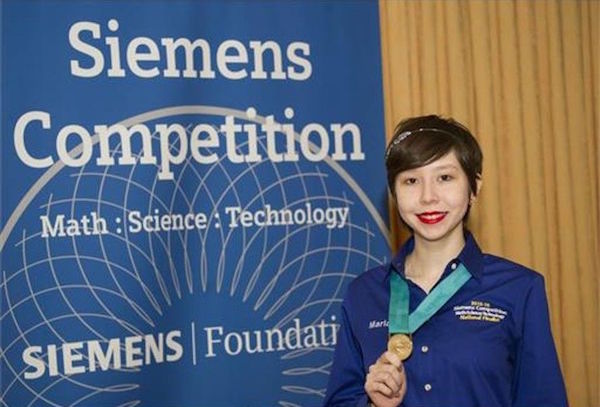17-year old Maria Elena Grimmett won the prestigious Siemens Competition in Math and Science for developing a new water purification method that can remove pharmaceutical pollutants from water.
Maria Elena Grimmett was 11 when she noticed that her family’s well water was tinged brown, and she wondered why.
Her curiosity sparked a six-year investigation into a new way to solve a common water pollution problem, and on Tuesday, that inquiry — conducted largely at Grimmett’s dining room table — won her a prestigious prize for young researchers and a $100,000 college scholarship.
“Oh my goodness. I can’t tell you how shocked I was,” Grimmett, now 17, said outside an auditorium at George Washington University, which hosted the final round of the 2015 Siemens Competition in Math, Science and Technology.
Grimmett’s initial questions about the color of her family’s water led her to learn about pharmaceutical pollution in the Florida Everglades. She was disgusted, and she wanted to help solve the problem. “I couldn’t imagine how people were letting this happen,” she said.
So she settled on figuring out a new way to remove sulfamethazine, a common veterinary antibiotic used in pigs and cows, from water. Sulfamethazine contamination is common in rural areas, she said, and is helping to create antibiotic-resistant bacteria that are a serious threat to public health.
Grimmett experimented with a resin called MN250, which she said are “basically tiny plastic beads.” The beads are chemically sticky, attracting the antibiotics and pulling them out of the water. Grimmett has experimented to see under what conditions the beads work best. “With all the charts and graphs I’ve made, water engineers can design systems” to treat drinking water at scale, she said.
In 2013, she became the youngest author to publish original research in the history of the 43-year-old Journal of Environmental Quality, according to the Siemens Foundation. She said she owed the many researchers who had opened and answered her e-mails asking questions about their work.
“Whenever I’m trying to read an article and I have no idea what it’s saying, I just email the author,” she said. “My mentor is the scientific community.”
Now a senior at Oxbridge Academy of the Palm Beaches in West Palm Beach, Fla., Grimmett said she wants to attend a top university where she’ll have an opportunity to do research. But she’s not sure what kind of scientist she wants to be — she has more exploring to do before she makes a commitment.
“I feel like it’s hard to say since I haven’t had a chance to discover all the fields,” she said.
Siemens also named winners in the team prize category, who will share a $100,000 prize. They are Christine Yoo and Kimberly Te, two 17-year-old seniors from Manhasset, N.Y., who have been friends since first grade.
They developed a device made of natural materials — a type of cucumber, to be exact — that not only cleans up oil pollution but also yields sustainable energy as a side benefit. They have one patent pending and another in the works.
Grimmett said she wasn’t surprised that the competition’s three winners are all young women, despite plenty of public conversation about the under-representation of girls in science.
“In our generation, we’ve come to the realization that women can do the same things as men,” she said.
Source: WashingtonPost
